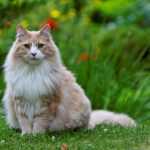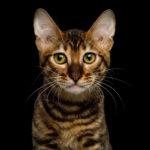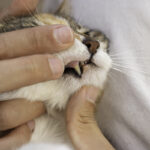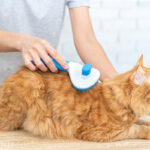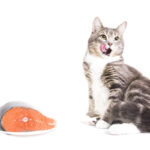Looking to bring a long-haired cat into your home? Well, if you are not aware, let me tell you about the most beautiful Norwegian Forest Cat. It’s an ancient cat breed descended from the domestic felines mostly seen in Northern Europe during the reign of Roman power.
These striking personalities attract people with their long hair and dense undercoat. If you are seeking to adopt an excellent family-friendly pet with a gentle personality then, the Norwegian Forest Cat is a perfect addition to your family.
Despite having wild looks due to their muscular body, Norwegians are well-mannered and easygoing felines. Want to know more about this ancient breed? If so, just go through this post. Learn more about this chunky and cool-hearted Norwegian Forest Cat. Take a look!
Contents
- Norwegian Forest Cat Profile
- History of Norwegian Forest Cat
- Characteristics of Norwegian Forest Cat
- Appearance of Norwegian Forest Cat
- Norwegian Forest Cat Care
- Diet and Nutrition for Norwegian Forest Cat
- Health Issues of Norwegian Forest Cat
- Pros & Cons of Having Norwegian Forest Cat
- Facts about Norwegian Forest Cat
- Norwegian Forest Cat FAQs
- Conclusion
Norwegian Forest Cat Profile
The Norwegian Forest Cat is a large long-haired domestic cat breed that originated in Norway, Northern Europe. Norwegian Cats are quite popularly known as Norsk skogskatt and Norsk skaukatt. Due to its originated location, this cat breed is highly habituated to extremely cold climatic conditions.
Moreover, these cats come featured with long and dense glossy hair alongside a woolly undercoat that protects their skin from extreme coldness. Norwegian Forest Cat is pretty good at climbing due to their sturdy claws.
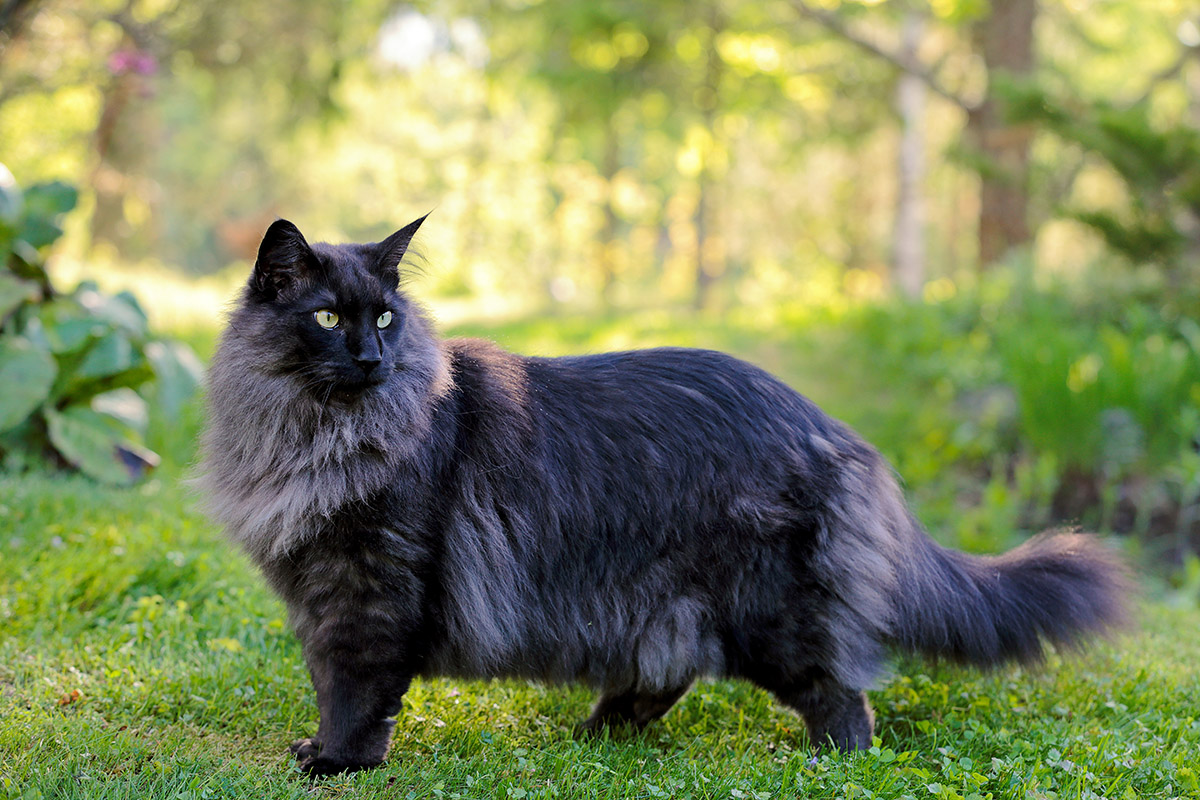
The ancestors of the Norwegian forest cat survived for centuries in the forests of Norway because of their thick and long coats. Currently, these cat breeds have turned out to become the most beloved domestic cats that are extremely friendly toward humans, especially in families.
Still, these cats don’t like to lay in any person’s lap for a long time. In terms of characteristics, the Norwegian forest cat is a gentle and affectionate feline, popularly called a wegie in the US. Due to their long thick hair, they often shed a lot and make sure you have a branded vacuum at home to clean up the mess all the time. Get to know the Profile of the Norwegian Forest Cats furnished below in the tabular form.
| Cat Breed | Profile |
| Official & Common Name | Norwegian Forest Cat |
| Other Names | Wegie, Skogkatt, Norsk skaukatt |
| Group | Natural, Medium to Large Sized and Long-Haired Cats |
| Height | 9 to 12 Inches |
| Weight | 12 to 16 Pounds |
| Coat Length | Long Hair with a thick undercoat |
| Coat Colors | Beige, Orange-White, Black, Gray-Cream, Lavender-Tan, Ebony-Blue, Silver-Red, Gold, Brown, Blue-Cream [Almost 60 shades with and without white markings] |
| Life Span | 14 to 16 Years |
| Coat Pattern | The most common coat pattern is Tabby and others include solid, bicolor, tortoiseshell, calico, and tabby fur |
| Origin | Norway |
| Shedding Amount | Heavy Shedding during the spring and fall seasons |
| Eye Color | Different shades of green, blue in partially white cats, copper, green-gold, Odd-Eyed |
| Hypoallergenic | No |
| Personality Traits | Friendly, Laid-back and Adaptable, Adventurous, Independent, Highly Interactive, Loving, Calm, Great Cuddlers, Affectionate, Easygoing, Kid-friendly, Family-friendly, Curious, Easy to train |
| Price | $ 900 – $ 1,500 |
| Perfect for | Families with children and other pets |
History of Norwegian Forest Cat
The Norwegian Forest Cat’s native is Norway and its origin happened centuries back maybe it could be about 1000 years ago. A bunch of fairy tales and legends were said about this cat breed. One among them is that this cat breed played a key role in the story saying that the chariot of the Norse Goddess Freya was pulled by 6 mammoth forest cats.
Although the origin of the Norwegian Forest Cat remains a mystery, it is said that this cat lineage was from the time of the Vikings. There were several images and writings of the felines slightly identical to the Norwegian Forest Cat from the 16th century.
By the 20th century, this cat breed almost lost its pure existence due to the random cross-breeding performed with other cat breed types. Further, people understood that the Norwegian Forest Cat is an extremely noteworthy breed considering it as a national treasure.
In the year 1938, Olav V – the King of Norway gave royal recognition to the Norwegian Forest Cat as the National Cat Breed of Norway. After several decades, the cat breed fanciers in Norway secured the breed and helped in increasing the breed number by undertaking careful breeding programs.
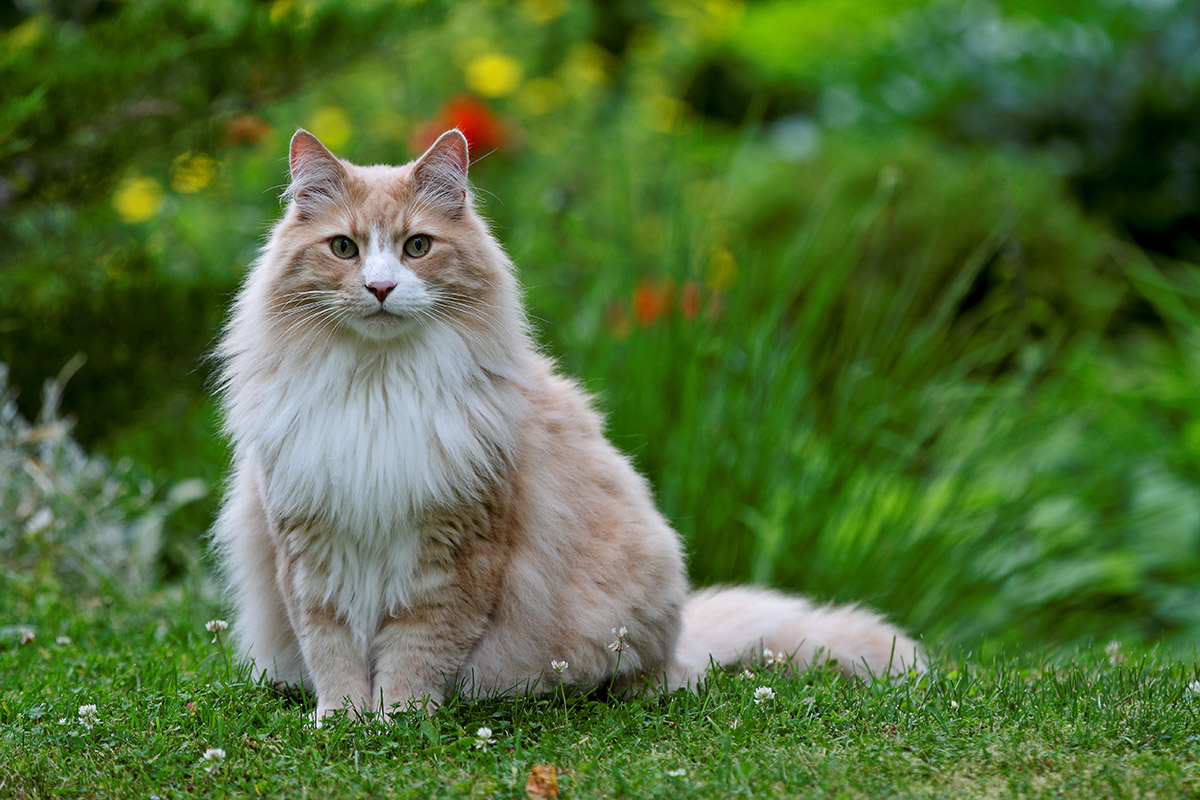
The International Feline Federation [Fédération Internationale Féline] had granted provisional recognition to the Norwegian Forest cat breed in 1976. This federation has recognized this breed as a pedigree cat that could be exhibited at various shows on the European continent. In 1977, this breed acquired full pedigree recognition permitting the cats to participate in the cat shows for champion title.
Later, in the year 1979, the first Norwegian Forest Cat evolved in the United States. In the year 1984, The International Cat Association approved the Norwegian Forest Cat for championship status. Further, in the year 1993, The Cat Fanciers Association approved the full championship status of the Norwegian Forest Cat.
Characteristics of Norwegian Forest Cat
Norwegian Forest Cat is an excellent cat breed with a wide array of characteristics. It has high energy levels and is extremely sociable. If you are planning to get this cat breed into your home, you must initially know the Norwegian Forest Cat Characteristics.
The characteristics of a cat include its physical traits and personality traits. The physical traits of a cat comprise its appearance, measurements like size, body type, hair, coat pattern, eyes, color, etc. On the other hand, the personality traits of the cat include its character, mentality, temperament, energy levels, lifespan, trainability, sociability, etc.
In short, if you are exploring a cat with a hulk-like body, high intelligence, and playfulness then, the Norwegian Forest Cat is a perfect feline. Get to know more about the physical traits and personality traits of a Norwegian Forest Cat.
Physical Traits
- Norwegian Forest Cat needs more time to mature compared to other cat breeds that usually mature at 5 years of age.
- At the age of 5, a Norwegian Forest cat which has a heavy-built structure loves to climb and has excellent hunting skills.
- Norwegian Forest Cat Size varies in the gender of the cat. An adult male Norwegian forest cat weighs between 12 and 16 pounds. On the other hand, a female Norwegian forest cat weighs from 9 to 12 pounds as they are comparatively smaller than a male cat.
- In general, a Norwegian Forest Cat owns a sturdy physique with long hair and a broad chest. The cat’s head appears in the shape of an equilateral triangle featuring a straight nose, medium to large ears, and a pair of almond-shaped eyes.
- Norwegian Forest Cat comes in a wide array of sizes, colors, and coat patterns. A Black Norwegian Forest Cat appears like a smokey black while in rest position.
- Norwegian Forest cat comes equipped with thick water-resistant fur that protects its skin from extremely cold climates. In addition, a dense ruff of fur is formed around the neck of adult Norwegian forest cats rendering them extra protection from the cold.
- This cat comes with large pointed ears alongside a long tail almost resembling a plume.
- The wide range of coat colors of Norwegian Forest Cat includes black, blue, cream, golden, white, red, and solver. The variety of coat patterns of a Norwegian Forest Cat include tortoiseshell, bicolor, calico, tabby, and solid.
- The lifespan of a Norwegian Forest Cat without any health issues ranges between 14 to 16 years and sometimes longer.
Personality Traits
Norwegian Forest Cat owns a fantastic personality just like several other cat breeds. These long-haired and large-bodied cats are affectionate, calm, and intelligent. Go through the list of noteworthy Norwegian Forest Cat Personality traits furnished below.
- Norwegian Forest Cats are great climbers and come with unique hunting skills especially while catching mouses outdoors. These cats own hunting instincts despite living in families as domestic cats.
- These long-haired cats are affectionate and as a result, they are quite popularly known as ‘Wegie’ by several pet parents.
- Norwegian Forest Cats are affectionate, calm, playful, intelligent, loyal, and curious. Once adopted, you will understand how adaptable and sociable the Norwegian Forest Cats are.
- Although these cats are sociable, they don’t always tend to be ‘lap cats’ unlike other cat breeds. Due to the fear of getting overheated, Norwegian Forest Cats don’t like to be cuddled in the hands of pet parents.
- Norwegian Forest Cats have a distinctive history as cats that work on farms develop well outdoors.
- Due to their adaptable nature, Norwegian Forest Cats get accustomed to different environments quickly and easily. This results in turning them into well-behaved indoor pets.
- Though the cat breed associations have classified them as quiet cats, certain cats in this breed are pretty much vocal.
- Like other cats, Norwegian Forest Cats don’t need much attention. However, they love to make friends and mingle with everyone they encounter.
- With their wonderful personality and behavior, Norwegian Forest Cats are ideal for families with kids and other pets.
- Due to their dense fur, Norwegian Forest Cats can’t adapt to hot weather and surroundings filled with heat. Apart from this one thing, Norwegians are great pets to spend time with.
- Norwegian Forest Cats love to spend most of their time indoors only when they have a soft and comfortable surface to take quick and frequent naps.
- You may witness a few similarities between a Norwegian Forest Cat and a Maine Coon. The major similarities between the two cat breeds include large structure, ultra-dense fur and coat, unique hunting skills, etc.
- There are some beliefs that the Norwegian Forest Cats had some contribution to the development of a Maine Coon cat breed as the Norwegian Forest Cat is a natural cat breed.
- Norwegian Forest Cats are highly energetic cats and make high-pitch vocalizations especially chirping.
- In terms of pet-friendliness, Norwegian Forest Cats can easily get along with other cats and well-behaved dogs.
| Personality Traits | Level |
| Energy Level | Medium |
| Kid-Friendly | High |
| Intelligence | High |
| Shedding Amount | High in specific seasons |
| Affectionate | Medium |
| Exercise Requirements | Medium |
| Vocalization | Low |
| Grooming Needs | Minimal |
| Trainability | High |
| Sociability | High |
| Health Issues | High |
| Pet-Friendly | High |
| Adaptability | High |
| Stranger-Friendly | Medium |
| Friendliness | High |
| Playfulness | High |
| Loneliness | Can’t be left alone for a long time |
| Inquisitiveness | High |
Appearance of Norwegian Forest Cat
Norwegian Forest Cat’s appearance is quite identical to a large, long-haired cat breed – Maine Coon originated in New England. As you have already read the Norwegian Forest Cat Traits, let’s get to learn more about the appearance of a Norwegian Forest Cat.
These cats are highly renowned for bearing long Nordic winters and extremely cold temperatures because of their thick and long undercoats. With their large body, fluffy britches, long hair, and clustered paws, Norwegian Forest Cats appear to have a rugged appearance.
From the side view, we can witness that the Norwegian Forest Cat comes with a sleek look. In terms of their profile, the Norwegian Forest Cat owns a straight outline sloping down from the brow bone to the nose tip. This results in a triangular appearance of this cat breed.
Other distinctive Norwegian Forest Cat Characteristics physically include big almond-shaped eyes and large ears that are arched forward. In general, the Norwegian Forest Cats have a huge muscular physique, and as a result, their weight ranges from 12 to 16 pounds. However, the male cats are slightly larger compared to the female cats in this cat breed. Their long shaggy tail and extremely dense coat of fur renders them a larger appearance.
Norwegian Forest Cat’s dense undercoat needs frequent brushing and maintenance to keep it in a healthy condition. In the spring season, the Norwegian Forest Cats will shed a lot. The eyes of this cat come in a variety of colors including copper, gold, shades of green, and a shade that lies among these three colors.
Norwegian Forest Cats can be seen in a plethora of colors and coat patterns. The variety of Norwegian Forest Cat Colors includes silver, gold, blue, red, black, white, and cream.
The wide array of coat patterns of the Norwegian Forest Cat includes tabby fur, tortoiseshell, solid, bicolor, calico, etc. The Norwegian Forest Cat owns strong and sturdy claws rendering them the ability to climb trees and hard rocks as well.
Norwegian Forest Cat Care
Worried about the Norwegian Forest Cat’s care? Well, the Norwegian Forest cat requires pretty much more attention and care compared to other cat breeds. This is due to their long and thick hair that usually sheds a lot during the spring season.
Apart from grooming, Norwegian Forest Cat care includes exercise requirements, training needs, vet care, etc. It’s also important to check whether this cat is getting adequate nutrition that its body requires as part of the cat care. Here is everything you need to know about the Norwegian Forest Cat care.
Grooming
The Norwegian Forest Cat owns a very thick and dense double undercoat. However, this cat needs far less grooming needs in terms of frequency. This cat needs brushing or combing every week to evade mats and maintain the health and glossy condition of the cat’s coat.
During the spring and fall seasons, the frequency of brushing and combing should be increased as it sheds a lot in these seasons. Usually, pet parents love to give a lion cut to their Norwegian Forest cats specifically the indoor cats that don’t have access to high air-conditioning during the summer months.
Using a bristle brush, wire slicker brush, or a stainless steel comb, you can brush the Norwegian Forest Cat’s long and thick fur. While giving a bath, it’s very arduous for the pet parent to wet it fully because of its water-resistant coat.
Other needs of the Norwegian Forest Cat include dental hygiene. Daily dental cleaning would be the best but if it is not possible weekly dental brushing would be sufficient. To prevent periodontal disease in the cat, you must make sure that the cat is given a good tooth brushing regularly.
Trim the nails of the cat regularly to maintain the cat’s claws. Make sure you trim the cat’s nails in short size to prevent the cat from becoming aggressive and scratching or damaging the furniture.
Ear hygiene is also important to maintain the health of the cat’s ears. To evade ear infections in the cat, it is highly essential to clean the cat’s ears every week. Checking the cat’s ears frequently is very important. If you notice debris associated with a bad smell or redness in the cat’s ears, immediately speak to your veterinarian to prevent further infection in the cat’s ears.
Eye care is another important step as part of the Norwegian cat’s maintenance. Although no exclusive eye care is necessary for this cat, it is still important to witness any sort of changes in the cat’s eyes like eye discharge, redness in the eyes, etc.
Exercise and Training
Norwegian Forest cats are moderately energetic and active cat breeds. The Norwegian Forest Cat often likes lounging but it doesn’t indicate that the cat is totally lazy. These cats love to run, jump, and climb frequently to fulfill their instincts.
One of the exceptional skills of the Norwegian Forest Cat is to descend from a cat tree keeping its head first. In a single leap, the cat can come down from a tree due to their size. As part of boosting their physical health and fulfilling their exercise needs, provide the cat with various enrichment items.
Some of them include big scratching posts, tall cat trees, birdwatching stations, outdoor cat enclosures, and a variety of pet-specific toys. By providing a variety of shelves at different heights, your cat can sleep a lot on them instead of climbing on your kitchen cupboards and damaging your bookshelves.
Norwegian Forest Cats are highly intelligent felines. As these cats love to spend more time with their pet parents, they tend to learn a lot from the owners. Hence, it would be quite easier for the owners to give them necessary pet training.
If you give training to the Norwegian Forest Cat like teaching them the basic commands, it helps you communicate with the cat in the best possible way. Moreover, training helps in boosting and stimulating the mental and physical health of the cat.
After the training session, you can give your favorite toys and treats to them as rewards so that you can keep the cat engaged during the session. The training session includes teaching them how to walk on a leash, giving a high-five, and giving them basic commands like sitting, staying, and more.
Norwegian Forest Cats can also be given potty training very easily. However, they require a huge litter box so that they can comfortably go potty.
Vet Care
If you have recently brought a Norwegian Forest Cat into your house then, you must initially take it to a veterinarian. Get a complete body checkup of the cat to identify if there are any health concerns. If everything is fine, you can just speak about the cat’s diet and the quantity to feed it daily.
If you want to introduce any new food to your cat, make sure you consult the vet. Take the Norwegian Forest Cat for regular check-ups, follow-ups, etc., to ensure the cat’s good health and overall well-being.
Diet and Nutrition for Norwegian Forest Cat
Every feline is different and each one has their tastes, preferences, and requirements especially when it comes to food and nutrient intake. Norwegian Forest Cat must be fed high-quality cat food ensuring it gets all sorts of nutrients its body needs. It is eventually important to keep an eye on the cat’s diet to prevent it from overeating as there is a risk of this cat easily getting obese.
Norwegian Forest Cats come with a heavily built body structure and hence, this is the reason it shouldn’t get fat. To prevent your little kitty suffer from weight-specific health problems; make sure that you maintain the Norwegian Forest Cat’s weight by keeping it lean and beautiful enough.
Once a Norwegian Forest Cat gets weight-related health problems, it leads to severe heart issues, diabetes, hip dysplasia, and other issues. In terms of nutrition, the Norwegian Forest Cat must be given food in moderately measured amounts twice a day.
Make sure you don’t leave its food in the food bowl all day openly. If the cat has finished its meal, clean up the mess and place the bowl after cleaning. If the cat eats food like a snack without any proper timing, it could lead to excess weight gain.
Speak to the veterinarian or the original breeder from where you brought the cat regarding the healthy diet and food options of a Norwegian Forest Cat. Check whether the cat is eating wet food or dry food and consider its preferences.
Eventually, ask the veterinarian about the right type of food that must be given to the cat. Follow the vet’s advice and feed your cat accordingly. Ultimately, the good health of the cat is the major thing that every pet parent must remember and follow as well.
Health Issues of Norwegian Forest Cat
Usually, Norwegian Forest Cats have good health and are prevalently known for their long life. It’s not an exaggeration that a Norwegian Forest Cat can lead a happy life beyond 16 years. Any feline can suffer from certain health problems during their lifetime.
Some of the health issues could be congenital and some others could be viral diseases passed on to the cats from some other pets. However, there are some known health issues that a Norwegian Forest Cat is prone to in its lifetime.
Still, the health issues that we mentioned below don’t occur often in these cats. Also, not all cats are prone to these congenital diseases. But, what we say is that as a responsible pet parent, you must be aware of their health problems so that you can act fast whenever they suffer from any health issue.
Just like any other cat breed, the Norwegian Forest Cat is prone to certain congenital health problems like Hypertrophic Cardiomyopathy, glycogen storage disease Type IV, Hip Dysplasia, polycystic kidney disease, etc. In this post, we have furnished the list of health problems that a Norwegian Forest Cat may suffer from in its lifetime.
Glycogen Storage Disease Type IV
Glycogen storage disease type IV (GSD IV) is a type of health condition when glycogen doesn’t break down into glucose that can be used as fuel to carry out vital metabolic processes. The symptoms of Glycogen Storage Disease Type IV include muscle wasting, muscle tremors, regular episodes of collapsing, and more.
Hypertrophic Cardiomyopathy [HCM]
Hypertrophic Cardiomyopathy [HCM] is a common heart disease caused in different cat breeds and the Norwegian Forest Cat is not an exception. This disease is generally caused in cats when the heart muscle [hypertrophy] thickens.
Once this disease enters into critical stage, the heart fails to pump blood effectively to other body parts and organs resulting in congestive heart failure. As a result, the cat’s heart walls become thick causing blood clots. When the cat enters this stage then, the life of the cat will be at risk due to this fatal condition.
The major symptoms of HCM in cats include lethargy, breathing problems, low appetite, and more. To diagnose this health condition in the cat, the veterinarian will perform certain medical tests such as X-rays, EKG, ultrasound, and other essential tests.
Cats diagnosed with Hypertrophic Cardiomyopathy must be admitted to the hospital to provide necessary medical care. The vet will help the cat survive by giving lifelong medications. HCM is not a minor condition that can be neglected. It is a serious health condition that needs immediate medical assistance.
Hip Dysplasia
Hip Dysplasia is another health problem usually caused by the hip joint. When the cat’s hip joint doesn’t develop properly like in a normal and healthy cat, it leads to a loose joint. If this problem is ignored, it leads to arthritis in cats.
The key symptoms of Hip Dysplasia include low mobility, discomfort, cat limping, etc. If may notice some other symptoms in the cat including bunny hopping and you may witness the cat not jumping like before.
If this condition is in the initial stage, it can be easily managed with anti-inflammatories and other pain relief medications. If this condition leads to a critical stage then, the affected cat needs surgery.
To diagnose this condition, the vet will perform a physical examination and sometimes X-rays of the cat. To help reduce the damage caused to the cat’s joints, the vet usually prescribes joint supplements.
If you adopt or purchase the Norwegian Forest Cat from a reputable breeder then, you can get a pet with minimal risk of getting the medical conditions listed earlier.
Pros & Cons of Having Norwegian Forest Cat
Looking to adopt a Norwegian Forest Cat? If so, you must have some idea about the pros and cons of having a Norwegian Forest Cat. Check it out!
| Pros | Cons |
| Active and Energetic | Doesn’t wish to be a lap cat |
| Family-Friendly & Kid-Friendly | Cat’s Coat requires weekly brushing or combing |
| Pet-Friendly | Can’t stay alone for a long time |
| Bears Extreme Cold Temperatures | Prone to various Congenital Health Issues |
| Highly Adaptable Personality | |
| Athletic and Muscular Physique | |
| Great Climbers | |
| Excellent Hunters |
If you are planning for the Norwegian Forest Cat Adoption then, you can find them at any animal shelter or a cat rescue group. If you want to know the list of active Norwegian Forest Cat breeders then, you can visit the official websites of Cat Fanciers Association and The International Cat Association.
Facts about Norwegian Forest Cat
We can expect at least a few interesting facts about various cat breeds and the Norwegian Forest Cat is no exception. Here is a list of the fun facts about a Norwegian Forest Cat. Check it out!
- Several cat breeds are similar to the Norwegian Forest Cat. Similar cat breeds include Maine Coon, Turkish Van, Siberian, and Nebelung cat breeds.
- Norwegian Forest Cat is a water-resistant cat that repels water. This is because their double undercoat usually protects the cat’s skin from extreme cold weather.
- An interesting fact about a Norwegian Forest Cat is that this cat is named in a fairy tale of the Norse Goddess. Freyja, the Norse Goddess used 6 cats to pull her chariot as per some depictions.
- King Olav V officially designated the Norwegian Forest Cat as a National cat of Norway in the 1950s.
- A plethora of folk tales were written about the Norwegian Forest Cat and they were excessively described as mountain-dwelling fairy cats namely ‘skogkatt’ owning unusual abilities.
- Norwegian Forest Cat is an ancient cat breed that shared its lives with humans for centuries.
- More than 60 different colors can be seen in the Norwegian Forest Cat breed such as red smoke, orange, bicolor, tortoiseshell, black, white, etc.
- One of the interesting facts about the Norwegian Forest Cat is that a woman who cherishes cats will get married. Another fact is that if you feed a cat pretty well then, it guarantees a sunny wedding day.
Norwegian Forest Cat FAQs
Here are some of the frequently asked questions related to the Norwegian Forest Cat, its habits, behavior, Norwegian Forest Cat Traits, price, availability to adopt or buy, and more. Check it out!
Is Norwegian Forest Cat Family Friendly?
Yes, the Norwegian Forest Cat is a perfect family-friendly pet that can mingle easily with children and other pets as well. However, this cat shows love and affection towards kids and other pets if they treat it politely and show some respect.
How Much Does A Norwegian Forest Cost?
A Norwegian forest cat’s price varies on different factors such as its availability, location it resides, gender, and the breeder’s reputation. However, it is expected that a Norwegian Forest Cat price may range between $600 and $1200.
A typical Norwegian Forest Cat price may sometimes start at $1000 and go up to several thousand if it is a show-quality kitten and the cost depends on the type of pedigree cat.Are Norwegian Forest Indoor Cats?
Norwegian Forest Cats love to roam in big spaces and adores spending more time outdoors. However, Norwegian Forest Cats may not always remain outdoors. As these cats are highly adaptable to their surroundings, they can easily adjust to any environment without much struggle.
How Long Do Norwegian Forest Cats Live?
The average longevity of a Norwegian Forest Cat will range between 14 and 16 years. However, some cats may survive for a long time and extend their lifespan with proper care.
How Big Do Norwegian Forest Cats Get?
The size of a Norwegian Forest Cat depends on its gender. A fully grown male Norwegian Forest Cat weighs about 16 pounds. On the other hand, a female Norwegian Forest Cat may grow to about 12 pounds.
Conclusion
That’s all! This is everything you need to know about the Norwegian Forest Cat, its characteristics, health issues, origin, diet, and a lot more. We hope this article has given adequate information about the adoption availability, price, and behavior of this long-haired heavily built cat.
Do you still have any queries about this post? If so, let us know in the comments section. Stay tuned to our website to learn more about the cat breeds, their traits, price, appearance details, health problems, etc.
